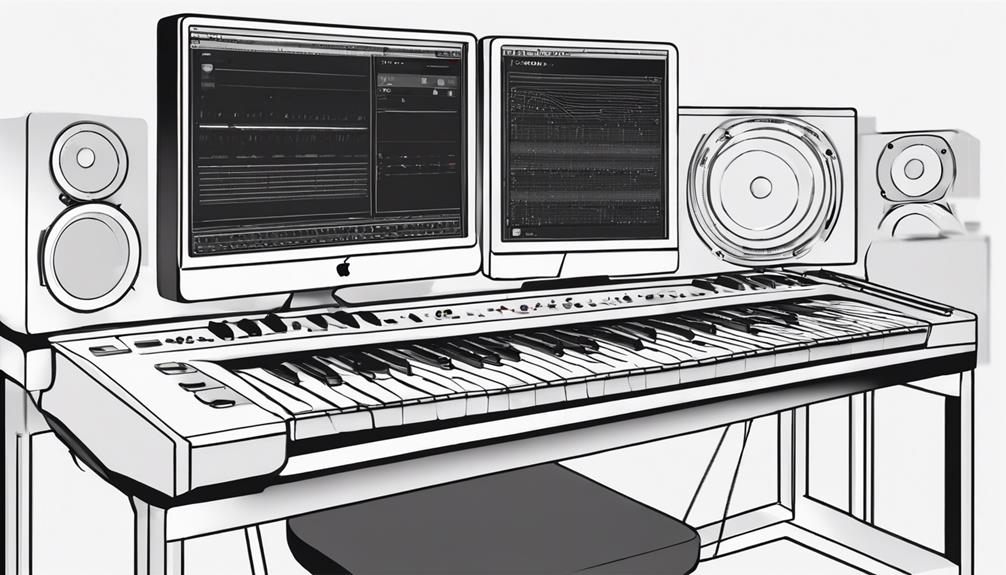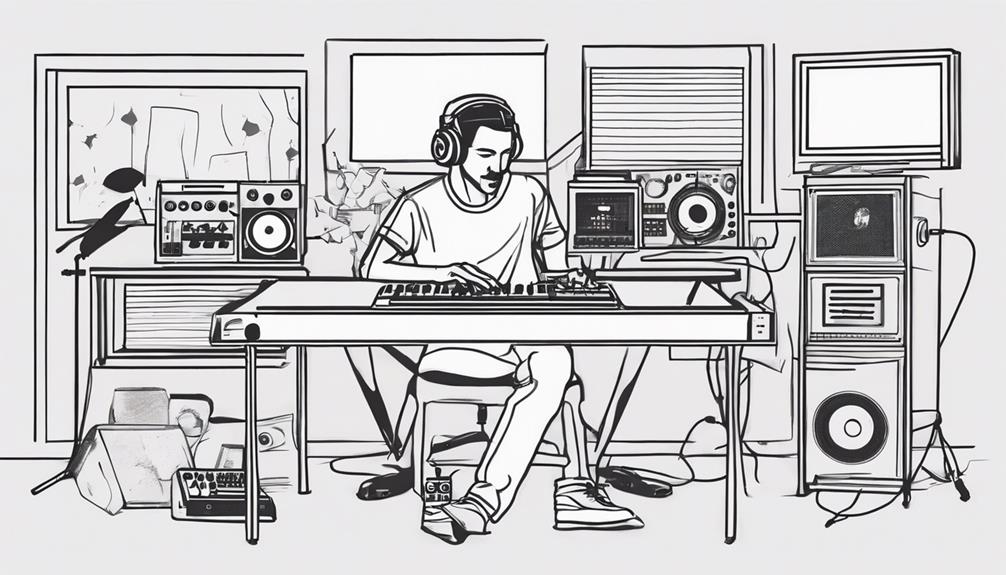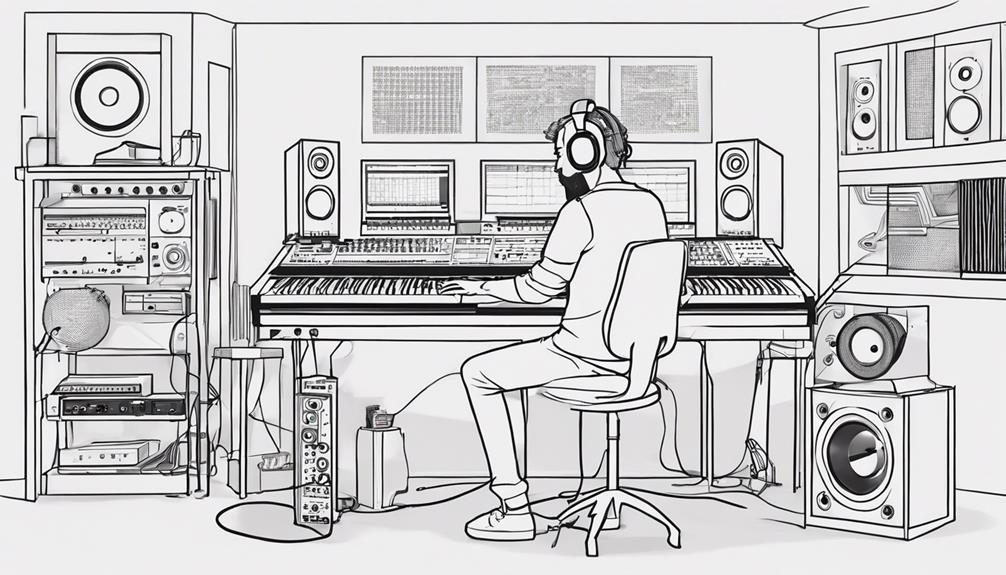Master the art of compression in music production by adjusting threshold and ratio settings to control dynamic range and maintain consistency. Experiment with attack and release times for precise signal manipulation. Utilize sidechain compression to create space and definition in your mix, and parallel compression to add depth and impact while preserving dynamics. Explore advanced strategies like multi-band compression and dynamic EQ for nuanced control over your audio. Harness the potential of compression techniques in your music production to elevate the quality and impact of your creations. Master the art of compression in music production by adjusting threshold and ratio settings to control dynamic range and maintain consistency. Experiment with attack and release times for precise signal manipulation. Utilize sidechain compression to create space and definition in your mix, and parallel compression to add depth and impact while preserving dynamics. Explore advanced strategies like multi-band compression and dynamic EQ for nuanced control over your audio. Harness the potential of compression techniques in your music production to elevate the quality and impact of your creations. Combine these methods with complementary effects, such as using delay in music production, to enhance spatial depth and rhythmic complexity. By blending creative processing with meticulous control, you can achieve mixes that are both polished and emotionally captivating.
Key Takeaways
- Set threshold and ratio for dynamic range control.
- Adjust attack for transients and release for natural sound.
- Utilize sidechain compression for mix clarity.
- Experiment with parallel compression for depth.
- Incorporate advanced strategies like multi-band compression.
Basics of Compression in Music Production
To understand the basics of compression in music production, you need to grasp its fundamental purpose and application. Audio compression is a technique used to control the dynamic range of sound signals, reducing the volume gap between the quietest and loudest parts.
By applying compression, you can guarantee a more consistent and balanced sound throughout a track. The key parameters to comprehend for effective compression are threshold, ratio, attack, and release.
Threshold sets the point at which compression begins to act on the audio signal. Ratio determines how much the signal above the threshold will be attenuated.
Attack refers to how quickly compression is applied once the signal exceeds the threshold, while release dictates how fast the compression stops acting once the signal drops below the threshold. Understanding these elements is essential in achieving the desired outcome of enhancing audibility, cohesion, and balance within your music mix.
Understanding Threshold and Ratio

Understanding the threshold and ratio settings in compression is essential for shaping the dynamics and impact of your audio signal. Here's what you need to know:
- Threshold: This parameter sets the level at which compression starts affecting the audio signal. It's measured in dB and determines when compression kicks in.
- Compression: The ratio controls how much the signal is reduced once it surpasses the threshold. Expressed numerically (like 4:1), the ratio influences the intensity of compression applied.
- Audio Signal: Threshold and ratio settings are vital for controlling the dynamic range of your audio signal. They determine how much the signal is attenuated, impacting the overall sound.
- Dynamic Range: Properly adjusting the threshold and ratio will help you achieve the desired intensity of compression, ensuring that your audio signal maintains its dynamics while controlling peaks and enhancing the overall impact.
Attack and Release Time Adjustment

When adjusting attack time on a compressor, you control how swiftly it responds to the input signal, affecting the initial transient. Faster attack times can tame peaks, while longer ones maintain the natural punch of the sound.
Proper release time adjustment dictates how long the compressor influences the sound post-threshold, shaping the decay and release phase.
Optimal Attack Settings
Adjusting attack settings on a compressor plays a crucial role in controlling how quickly it responds to incoming audio signals, directly impacting the initial transient impact in music production.
When considering attack times, keep in mind:
- Fast Attack: Ideal for taming sharp transients like drum hits, ensuring a more consistent and controlled sound.
- Slow Attack: Preserves initial transients, allowing for a more natural and dynamic feel in the music.
- Finding the Balance: Best attack settings depend on the audio material and desired effect, striking a balance between control and dynamic preservation.
- Experimentation: Trying out different attack times is key to shaping the rhythmic feel and overall impact of the compressed sound.
Adjusting Release Times
To control how long a compressor affects the sound after it falls below the threshold, adjusting release times is essential in music production. Release times determine how quickly or slowly the compressor stops affecting the audio signal.
Longer release times result in smoother changes and help maintain the natural dynamics of the sound. On the other hand, faster release times can lead to pumping effects and make the compression more noticeable, which may not always be desired.
It's vital to find the right release time that strikes a balance between control and preserving the natural sound of the music. Experimenting with different release times allows you to understand how they impact the overall sound and helps you fine-tune your compression settings to achieve the desired effect.
Finding Sweet Spots
To optimize the impact of compression on your music track, honing in on the ideal attack and release time settings is pivotal. Finding the sweet spot where these settings work harmoniously can greatly enhance the dynamics and overall compression sound of your track.
Here's how to adjust the attack and release times effectively:
- Attack Time: Longer attack times allow the initial transient of the sound to pass through, emphasizing punchiness and clarity in the audio. Shorter attack times smooth out transients, creating a more controlled and consistent sound.
- Release Time: This parameter determines how long the compressor continues to affect the audio after the signal drops below the threshold. A shorter release time can make the compression more noticeable, while a longer release time can result in a smoother and more natural sound.
- Sweet Spot Exploration: Experiment with different attack and release time combinations to find the sweet spot that best suits the dynamics and feel of your music track.
- Monitoring the Changes: Always listen carefully to how adjusting attack and release times impacts the overall sound, making sure it aligns with your desired compression outcome.
Makeup Gain for Level Adjustment
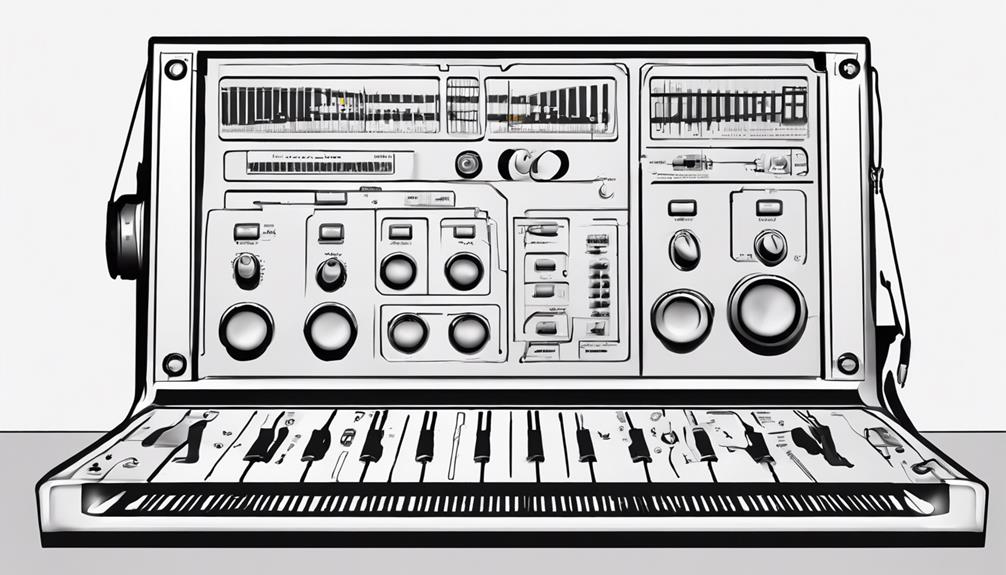
When using makeup gain in music production, you're basically boosting the compressed audio signal to match its original volume. This adjustment guarantees a consistent loudness level throughout the track.
Gain After Compression
Makeup gain plays an essential role in compensating for the volume reduction caused by compression in music production. After compressing a signal, the overall volume tends to decrease.
Here's why adjusting makeup gain is pivotal:
- Compensation: Makeup gain boosts the compressed signal to align its level with the original signal, counteracting the volume reduction caused by compression.
- Perceived Loudness: By adjusting makeup gain, you can guarantee that the overall perceived loudness of the track remains consistent before and after compression.
- Balanced Mix: Proper adjustment of makeup gain is key to achieving a balanced mix post-compression, where all elements sit well together in the mix.
- Consistent Levels: Utilizing makeup gain correctly helps maintain consistent levels across tracks, avoiding issues where some tracks may sound too quiet after compression.
Understanding how to apply makeup gain effectively will contribute significantly to the quality and balance of your music production.
Balancing Audio Levels
Boosting the overall signal level after compression, makeup gain is essential for balancing audio levels in music production.
When applying compression to a signal, the quieter parts are reduced in volume to even out the dynamic range. This can result in an overall decrease in volume, which is where makeup gain comes in.
By adjusting the makeup gain, you can boost the compressed signal to bring it back to an appropriate level, compensating for the volume reduction caused by compression.
This step is vital for maintaining a consistent volume throughout the mix, ensuring that no parts get lost or become too overpowering.
Properly setting the makeup gain allows you to bring up the quieter details in the compressed audio, helping it sit well in the mix without being too soft or too loud.
Mastering the art of makeup gain is key to achieving a balanced and professional-sounding mix in music production.
Compression Techniques for Mixing
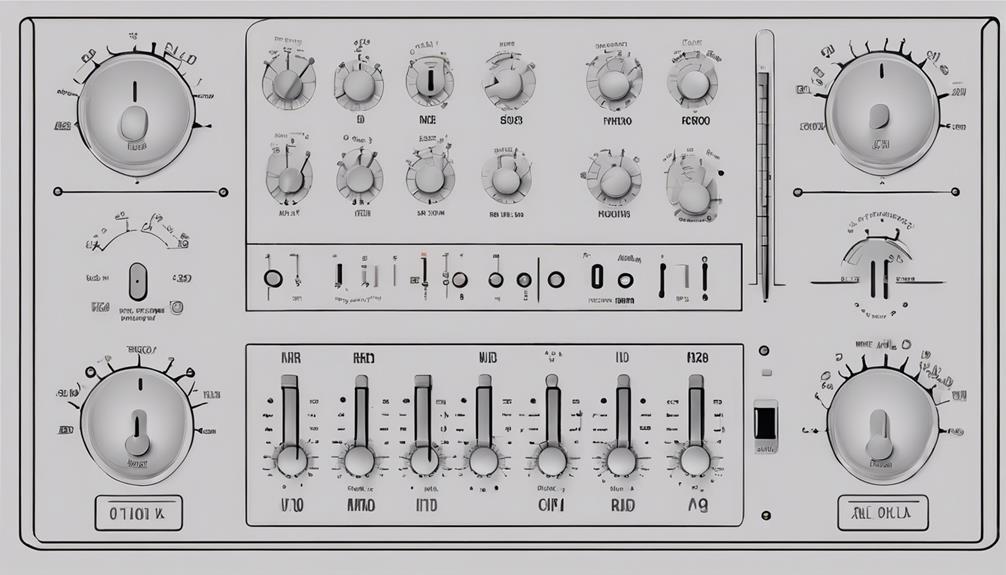
Using different compression techniques in mixing can greatly impact the clarity and cohesion of your tracks. Understanding parameters like threshold level, ratio, attack, and release times is essential for effectively utilizing compression to control dynamic range and balance levels.
Here are some key compression techniques to enhance your mixes:
- Sidechain Compression: By triggering compression on one track based on the input of another, you can create space and definition in your mix, particularly useful for tightening up bass frequencies when the kick drum hits.
- Parallel Compression: Blend compressed and uncompressed signals to add depth and impact to elements like drums or vocals, maintaining the dynamics while adding weight and energy.
- Dynamic Range Control: Adjust the threshold and ratio settings to manage the dynamic range of your tracks, ensuring a consistent and controlled sound throughout the mix.
- Attack and Release Times: Fine-tune these settings to control how quickly the compression engages and releases, shaping the transients and overall feel of the audio.
Parallel Compression Explained

Parallel compression offers you the ability to blend compressed and uncompressed signals, giving you greater control over the dynamics in your music. This technique allows you to maintain the original dynamics of your audio while injecting it with added punch and energy.
Benefits of Parallel Compression
When incorporating parallel compression in your music production process, you blend a heavily compressed signal with the original uncompressed signal to enhance depth and punch while preserving the dynamics and natural feel of the sound.
Here are some benefits of using parallel compression:
- Retain Dynamics: Parallel compression allows you to keep the original dynamics of the sound intact while adding power and impact through the compressed signal.
- Enhance Depth: By blending the compressed and uncompressed signals, you can create a sense of depth and space in your mix, making the sound more three-dimensional.
- Add Punch: The heavily compressed signal in parallel compression brings out the transient details and helps the sound cut through the mix, adding punch and energy.
- Control Over Sound: Using parallel compression gives you more control over the final sound by allowing you to adjust the balance between the compressed and uncompressed signals to achieve the desired effect.
Setting up Parallel Compression
To set up parallel compression effectively in your music production workflow, begin by creating a duplicate track of the original audio signal. This duplicate track will receive heavy compression to bring out details and add weight to the sound without losing the dynamics of the original signal. By blending this heavily compressed track with the original signal, you can achieve a more impactful and balanced sound.
| Original Signal | Heavily Compressed |
|---|---|
| Dynamics intact | Enhanced weight |
| Transients preserved | Added sustain |
| Natural sound maintained | Increased impact |
| Clarity retained | Depth and energy |
Sidechain Compression Applications

Using a secondary audio source to trigger compression on a primary track, sidechain compression offers versatile applications in music production. Here's how you can make the most of this technique:
- Ducking Effect: Achieve the classic 'pumping' effect by sidechaining one track to another, causing the volume of the first track to dip whenever the second track plays.
- Vocal Clarity: Enhance vocal clarity in a mix by sidechaining the vocals to a compressed instrumental track, allowing them to stand out without overpowering other elements.
- Rhythmic Effects: Apply sidechain compression to basslines, synths, or pads to create rhythmic effects that sync with the beat, adding movement and energy to your tracks.
- Groove and Dynamics: Improve the groove and dynamics of your mix by emphasizing specific elements through sidechain compression, enhancing the overall musicality and impact of the song.
Tips for Effective Serial Compression
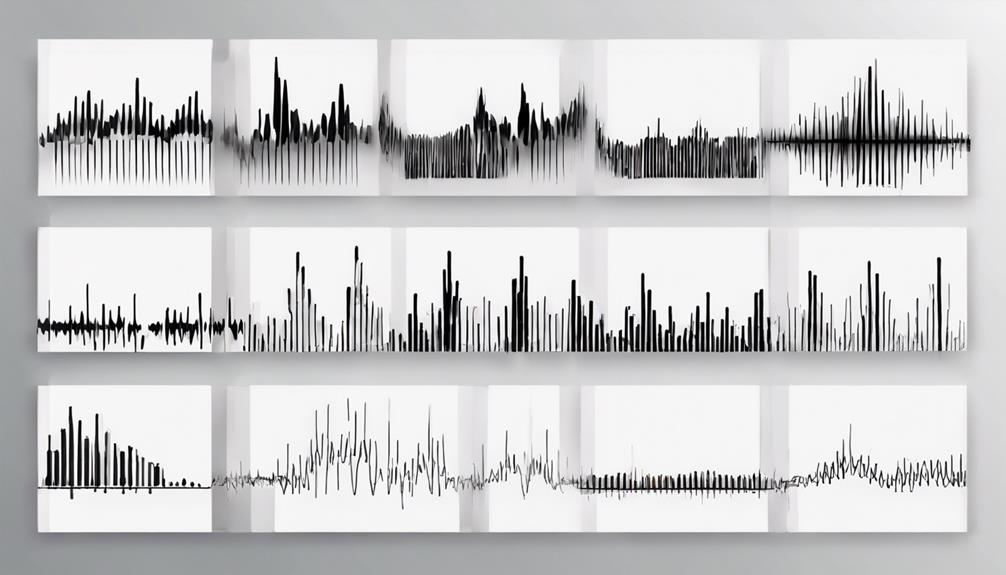
Enhance your sound's dynamics and control by implementing these key tips for effective serial compression in your music production workflow. When utilizing serial compression, stacking compressors in a chain can provide a more detailed and nuanced approach to shaping your sound. This technique is especially beneficial in vocal production, allowing you to address different dynamic ranges within the same track. Experimenting with various compressor settings in a serial setup enables you to find the ideal balance for your specific sound.
| Tips for Effective Serial Compression | ||
|---|---|---|
| 1. Target Specific Aspects | 2. Experiment with Settings | 3. Achieve Nuanced Control |
Avoiding Common Compression Mistakes
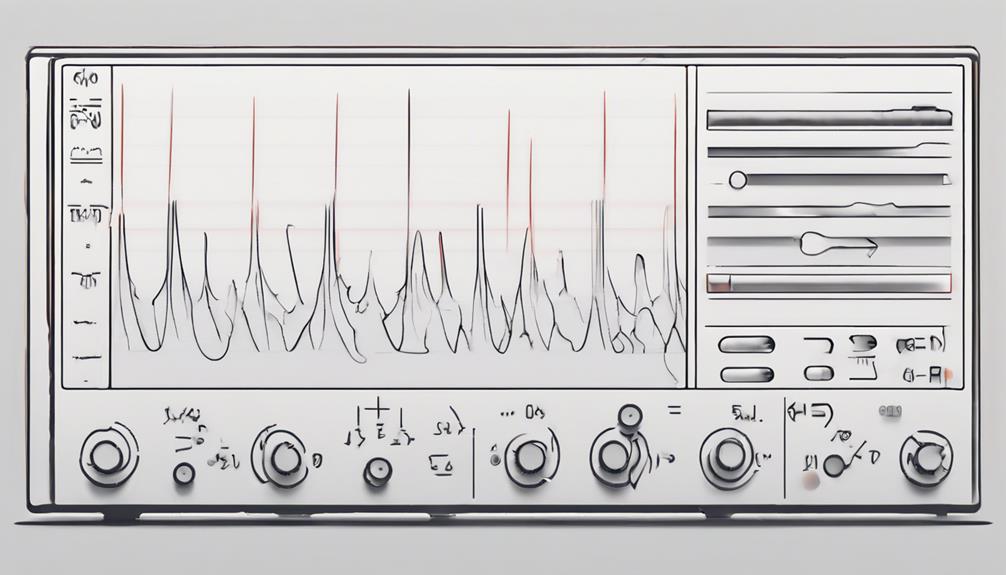
Avoiding common compression mistakes is crucial for maintaining the clarity and impact of your audio production. To guarantee you get the best results, keep these key points in mind:
- Setting the Threshold: Be mindful of setting the threshold too low, as this can make it challenging to perceive the compression's effect.
- Avoid Over-Compressing: Heavy compression can result in a loss of dynamics, higher frequencies, and a flattened sound.
- Using Multiple Compressors for Vocals: Instead of solely relying on one compressor for vocals, consider using multiple stages of compression or other techniques to preserve a natural and dynamic vocal sound.
- Experiment with Settings: Play around with different threshold, ratio, attack, and release settings to understand how each parameter impacts the audio. This experimentation will help you find the right balance and achieve the desired sound without over-compressing.
Advanced Compression Strategies

Employing advanced compression strategies in music production can greatly enhance the intricacy and impact of your sound. Multi-band compression allows you to target specific frequency ranges, giving you more precise control over the dynamics of your mix.
Parallel compression, also known as New York compression, combines both uncompressed and compressed signals to bring out subtle details while maintaining punchiness.
Sidechain compression, popular in EDM, uses an external audio source to trigger compression, creating rhythmic effects that add movement to your tracks.
Serial compression involves chaining multiple compressors together, offering nuanced control over the dynamic range of your music.
To further elevate your productions, consider incorporating dynamic EQ for dynamic frequency adjustments, upward compression to bring up quieter sounds without squashing louder ones, and advanced sidechain routing for creative sound manipulation.
Frequently Asked Questions
How to Use Compression in Music Production?
To use compression in music production, understand threshold, ratio, attack, and release settings. Shape and glue elements, enhance coherence, and improve clarity. Experiment with different techniques to master compression. Your mixes will benefit from the impact and balance compression brings.
What Is the Technique of Audio Compression?
Audio compression is a technique used in music production to control sound dynamics. Adjusting parameters like threshold and ratio on a compressor helps achieve balance. Understand how to apply compression effectively for professional-sounding tracks.
How Does Compression Work?
You've probably wondered how compression works in music production. It's like a magic hand that smooths out volume bumps, making your sound consistently smooth. Adjusting settings like threshold and ratio shapes the magic!
What Instruments Should You Use Compression On?
You should use compression on vocals to even out dynamics, drums for punch, bass for consistency, guitars for smoothness, and keyboards for sustain. It helps level out the sound and makes each instrument blend seamlessly in your mix.
Conclusion
So, now you know the basics of compression in music production. Remember, don't squash the life out of your tracks! Instead, use compression to enhance dynamics and add depth to your mixes.
Play around with different settings and techniques to find what works best for your sound. And remember, less is often more when it comes to compression.
Keep those levels in check and watch your music come to life!


